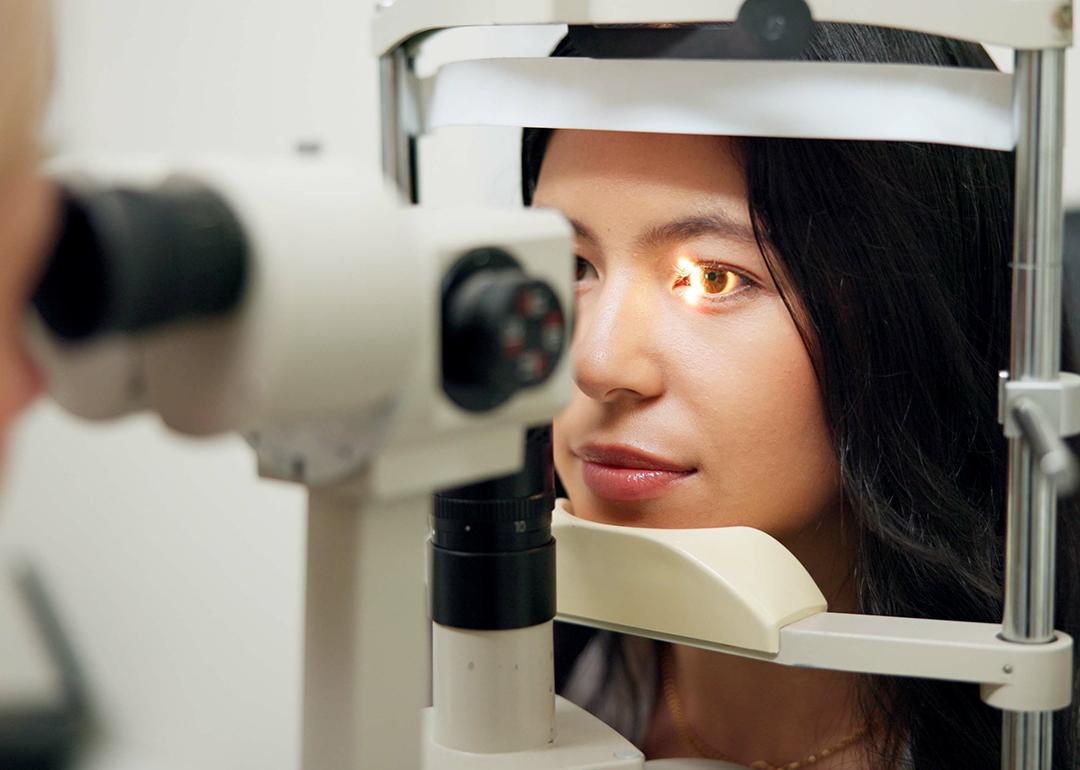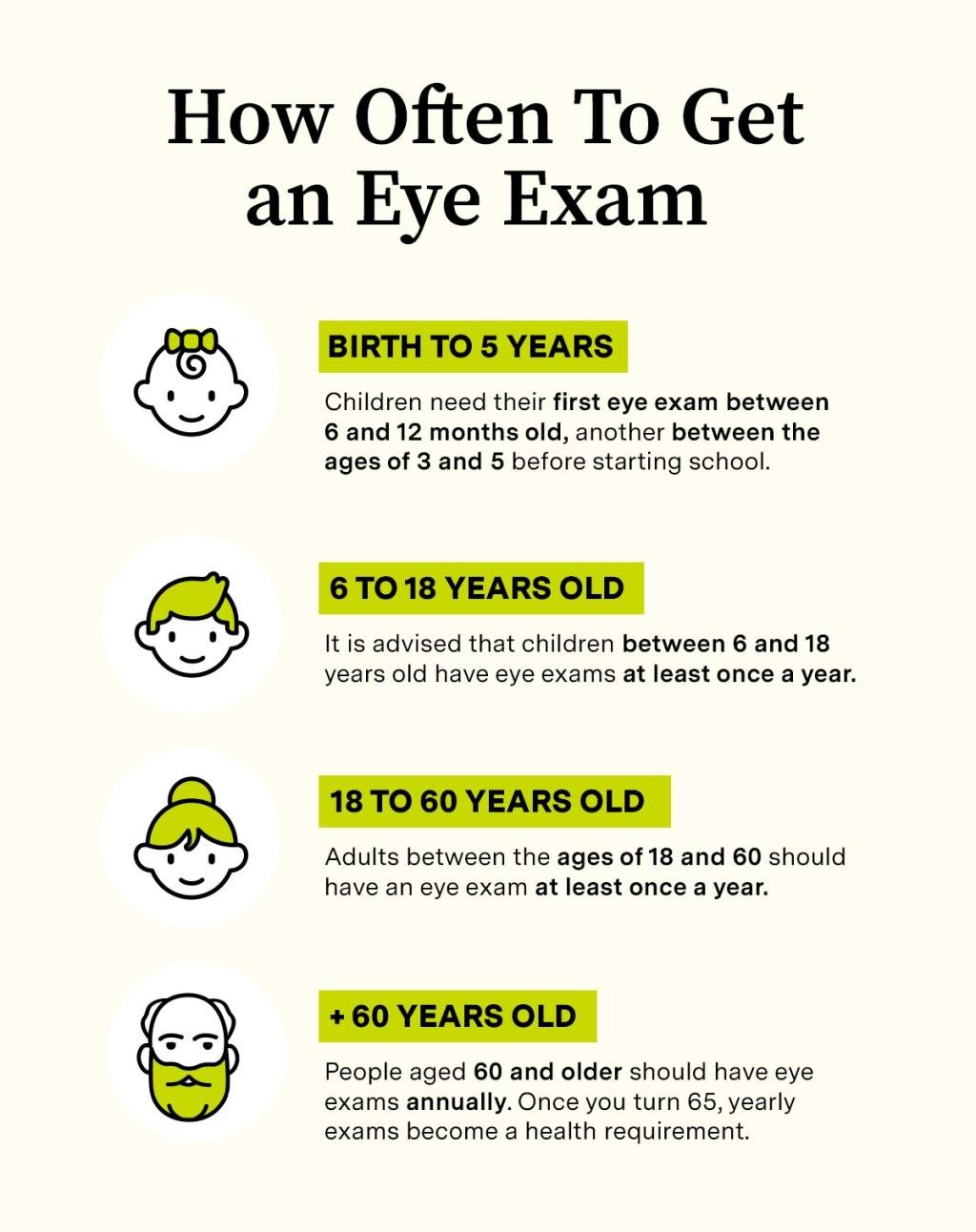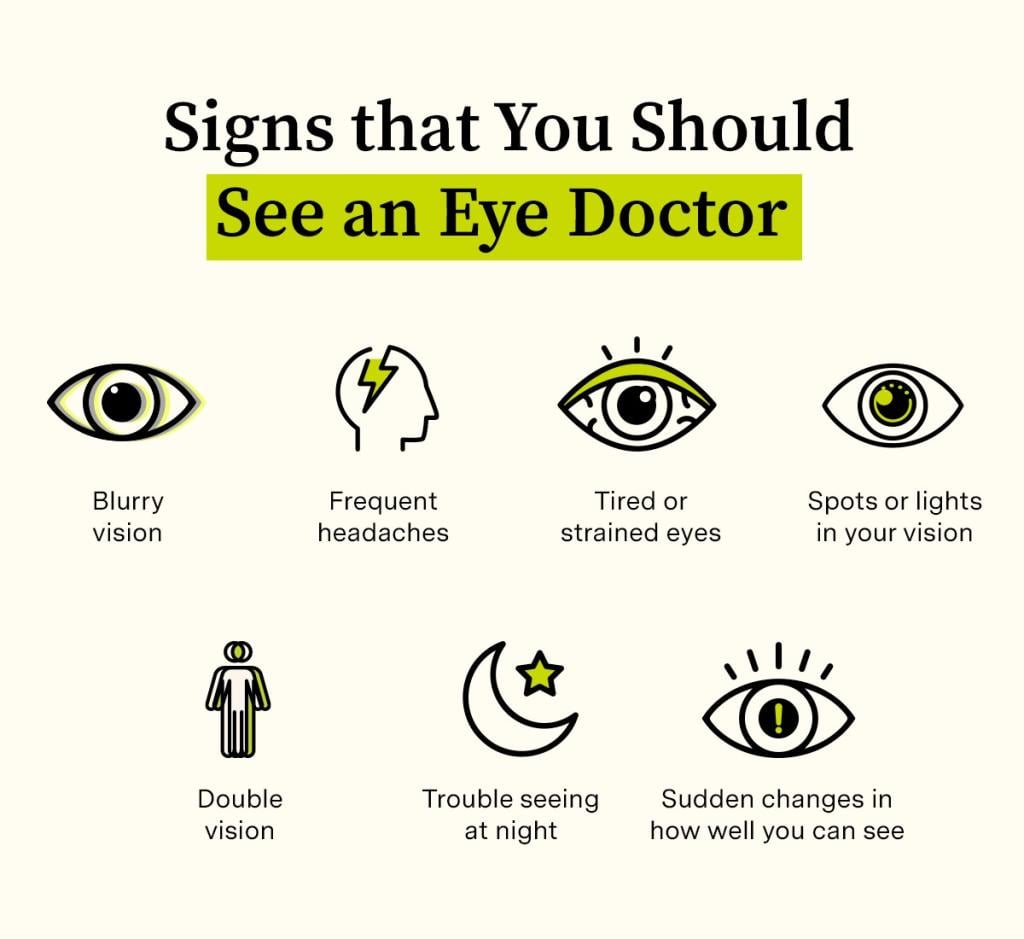
How often should I get my eyes checked?
How often should I get my eyes checked?
In general, adults should get eye exams every year, while children need them at 6 to 12 months, 3 to 5 years old and yearly during school. The exact frequency you should get your eyes checked depends on many factors, including your age, lifestyle, risk factors, medical conditions and whether you wear corrective lenses.
Getting your eyes checked regularly is important for maintaining healthy vision and overall well-being. Eye exams can detect eye problems before you notice them and spot signs of other health issues you might not know about. This guide from Eyemart Express will help you understand when to get an exam, what happens during these visits and signs you need to see an eye doctor right away.

How Often Should Adults Have Eye Exams?
The American Optometric Association (AOA) advises that adults aged 18 to 64 have eye exams at least once a year. Although serious eye diseases are less common in adults between 18 and 60, regular exams can catch early signs of problems and ensure glasses or contact prescriptions stay up to date.
While annual eye exams are standard, the AOA recommends that at-risk people have more routine eye exams. You should try to get an eye exam sooner if you have had eye surgery or injury, or work a job that is strenuous or hazardous to your eyes. You should also get more frequent exams if you:
- Have a family history of eye disease: If your parents, siblings or grandparents have eye problems, you're more likely to get them too. Eye conditions that run in families include glaucoma, macular degeneration, cataracts and severe nearsightedness. Tell your doctor about your family's eye history so they can watch for early signs of these problems.
- Have chronic health conditions: Some health conditions require more frequent eye exams. People with diabetes need yearly dilated eye exams to check for diabetic eye disease. High blood pressure, autoimmune diseases and long-term steroid use can also affect your eyes. These conditions can damage blood vessels and tissues throughout your body, including your eyes.
- Use corrective lenses: If you wear glasses or contacts, yearly exams help make sure your prescription is still correct and your eyes stay healthy. Contact lens wearers especially need regular checkups to prevent problems from lenses that don't fit right or are worn too long.
How Often Should Seniors Have Eye Exams?
People 60 or older should have eye exams every year to ensure healthy vision. As you approach 60 and beyond, you're more likely to develop issues like presbyopia (trouble focusing on close things), cataracts, glaucoma and macular degeneration. Once you turn 65, yearly exams become a health requirement.
All adults over 60 need dilated eye exams at least every two years for glaucoma screening, but yearly exams provide better protection. About 20% of Americans over 85 have permanent vision loss, which shows how important regular eye care becomes as you age.
Several eye conditions become more common with age, including:
- Cataracts cloud the lenses, making it hard to see clearly. About 17.2% of Americans over 40 have a cataract in at least one eye. The good news is that cataract surgery works well if done at the right time.
- Glaucoma damages the nerve that connects your eye to your brain. If not treated, it can cause permanent vision loss. Adults over 60 are six times more likely to develop glaucoma and need regular pressure checks and nerve exams to catch it early.
- Age-related macular degeneration (AMD) affects the center of vision, which you need for reading and seeing details. About 2.1 million Americans over 50 have the advanced form, which can cause severe vision loss. Finding it early means doctors can slow it down with treatment.
- Diabetic retinopathy becomes more common the longer someone has diabetes. About 9.6 million Americans have diabetic retinopathy, with 1.8 million having the type that threatens vision. People with diabetes need yearly dilated exams to prevent vision loss.
How Often Should Kids Have Eye Exams?
Children need their first eye exam between 6 and 12 months old, another between the ages of 3 and 5 before starting school, and yearly exams between 6 and 18 years old to support learning and healthy development.
Kids rely on good vision to learn and grow. About 80% of what children learn in school comes through their eyes, so specialized, modified learning is critical for children with visual impairments. CDC data shows nearly 6.8% of kids under 18 have vision problems, and many more have undiagnosed issues that affect their schoolwork and daily life. Finding and fixing vision problems early can greatly impact a child's success.
Eye exams can uncover several vision problems that often affect kids.
- Amblyopia: Commonly known as lazy eye, this condition requires early treatment for the best results.
- Strabismus: This condition, commonly known as crossed eyes, can lead to lazy eye if not treated.
- Nearsightedness, farsightedness and astigmatism: These focusing problems are common and easy to correct using lenses or contacts, especially when caught early.
- Color blindness: This condition is usually found during comprehensive testing.
- Eye focusing and tracking problems: These can make reading and, therefore, learning difficult.
Some children need eye exams more often than annually. Some risk factors include:
- Being born early or with low birth weight.
- Needing oxygen as a baby.
- Family history of eye problems.
- Having a mother who had an infection during pregnancy.
- Developmental delays or other health conditions.
Kids with these risk factors should see an eye doctor as often as the pediatrician recommends, which might be more than once a year.
Is Vision Screening Different From an Eye Exam?
Yes. Vision screening is a quick, basic test that only checks how far you can see clearly, while an eye exam is a complete check of your vision and eye health done by an eye doctor using special equipment.
Vision screenings provide a general assessment of potential vision problems so that a person can be sent for a real eye exam. They're often done at schools, doctors' offices, the DMV or health fairs by people who aren't eye specialists.
Vision screenings usually only test how well you can see letters on a chart from far away. Some might include simple checks for eye alignment or color vision. These quick tests take just a few minutes and use basic equipment.
The key differences between screenings and comprehensive exams include the following.
- What they test: Vision screenings only check distance vision. Complete eye exams look at near vision, how your eyes work together, eye pressure and the health of all parts of your eyes. Screenings can't find eye diseases or many vision problems.
- Who does them: Only eye doctors (optometrists or ophthalmologists) can perform comprehensive eye exams, as they have years of special training and the right tools. Vision screenings are often done by nurses, volunteers or school staff in rooms without proper lighting or equipment.
- What they can find: Eye exams can catch glaucoma, cataracts, macular degeneration and other serious problems with no early symptoms. Screenings can't find these conditions. The American Optometric Association reports that studies show that school vision screenings miss up to 75% of children with vision problems.
Regular vision screenings should not replace eye exams. Passing a vision screening does not mean your eyes are healthy. Many people pass screenings but still have eye problems. Only a comprehensive eye exam can tell if your eyes are healthy and working as needed.
Why Should I Get an Eye Exam?
Eye exams catch vision problems and eye diseases early, when treatment works best. They also find signs of other health problems that show up in your eyes, helping stop vision loss before it happens. Eye exams do much more than check if you need glasses. They look at your whole eye health to make sure everything works correctly.
The main benefits of scheduling regular eye checkups include the following.
1. Early Detection of Vision Problems and Eye Diseases
Eye exams can find problems before you feel or see anything wrong. An estimated 93 million adults in the United States could lose their vision, but only half saw an eye doctor in the past year. Eye exams catch problems like glaucoma, cataracts, macular degeneration and diabetic eye disease before you notice any changes. Many serious eye problems don't cause pain or vision changes until they've already done damage.
2. Identification of Systemic Health Issues
Your eyes can show signs of health problems in other parts of your body. An optometrist can detect more than 270 serious health conditions, including diabetes, high blood pressure, autoimmune diseases and cancers through eye exams. During an eye exam, doctors can see blood vessels and nerves in your eyes that might show signs of these health problems.
3. Maintaining Quality of Life and Independence
Being able to see clearly affects everything you do each day. You need good vision to read, drive, recognize people and move around safely. When adults can't see well, they often have trouble finding or keeping jobs and are more likely to feel sad or worried. Regular eye exams help make sure you can keep doing the things you love and need to do every day.
4. Prevention of Vision Loss
Many types of vision loss are preventable if caught early. Eye doctors can spot changes in your eyes and treat them before they cause lasting damage. For example, 90% of diabetes blindness can be prevented with proper care if detected early. Eye problems often progress slowly without warning signs, which is why regular checkups are so important.

How Do I Know if I Need an Eye Exam?
You should see an eye doctor if you have:
- Blurry vision that doesn't go away.
- Frequent headaches, especially after reading or using a computer.
- Tired or strained eyes during your normal activities.
- Spots or flashes of light in your vision.
- Double vision.
- Trouble seeing at night or when it's dark.
- Sudden changes in how well you can see.
Some eye problems require immediate care. Get emergency help if you have:
- Sudden vision loss in one or both eyes.
- Severe eye pain that won't go away.
- Flashes of light with a dark curtain or shadow in your vision.
- Lots of new floaters all at once.
- An eye injury.
- Chemicals in your eye.
Even if your eyes feel fine, you still need regular checkups. Many eye problems start slowly and don't cause any noticeable symptoms. Waiting until you have problems to see an eye doctor can mean missing the chance to treat issues when they're easiest to fix. Vision loss affects your whole life, making it harder to work, enjoy hobbies and stay independent.
What Happens During an Eye Exam?
A comprehensive eye exam includes many tests that check your vision and eye health. It usually takes 30 to 60 minutes to complete. Your eye doctor will start by asking about your health history and any vision problems. Then, they'll do several tests to check different parts of your eyes and how they work. Each test tells the doctor something important about your eye health.
Common eye exam tests include the following.
- Refraction testing: This test finds exactly what glasses prescription you need. Your doctor uses a machine called a phoropter that has different lenses. You'll look through it and tell the doctor which lens makes things look clear, helping them determine your prescription.
- Eye pressure testing: This test checks for glaucoma by measuring the pressure inside your eyes. The doctor might use a puff of air or gently touch your eye with a special tool. High pressure can damage your optic nerve over time.
- Eye movement testing: This test makes sure your eyes work well together. The doctor will ask you to follow a light or an object with your eyes to check that all your eye muscles are working correctly.
- Dilated eye exam: This exam lets the doctor see the back of your eyes. They'll put drops in your eyes to make your pupils bigger, allowing them to check your retina, optic nerve and blood vessels for signs of disease. The drops make you sensitive to light for a few hours.
- Slit lamp exam: The slit lamp exam uses a special microscope with a bright light to examine the front parts of your eye, like the cornea, iris and lens. This test can uncover problems like cataracts or corneal damage.
Your doctor might do other tests based on their findings or your specific needs. At the end of the test, they'll explain what they found and answer your questions.
How Do I Prepare for an Eye Exam?
You can prepare for your exam by doing the following:
- Get a good night's sleep so your eyes aren't tired.
- Wear your glasses instead of contacts.
- Don't wear eye makeup if possible, as it can interfere with some tests.
- Eat normally and take your regular medications unless instructed otherwise.
- Plan for someone to take you home if your test includes dilation.
On the day of your test, bring your vision and medical insurance cards, as different parts of your exam might be covered by each, and ensure you have your photo ID. If you wear contacts, bring them to the appointment in their case. Write down all medicines you take, including over-the-counter drugs and vitamins, with doses.
If you're visiting a new eye doctor, carry your old glasses prescriptions or eye exam records if you have them. You should also have sunglasses, as your eyes will be sensitive to light after dilation.
Before your appointment, note any health conditions, problems you've noticed or questions you have for the doctor. During the exam, don't be shy about:
- Telling the doctor about any vision changes, even small ones.
- Asking questions if you don't understand something.
- Discussing costs and payment options.
- Asking about new treatments or ways to protect your eyes.
- Getting clear instructions for any follow-up care.
Good preparation lets you get the most from your eye exam and helps your doctor take the best care of your eyes.
Frequently Asked Questions
Here are the answers to common questions about eye exams to help you plan for yours:
Do I Need an Eye Exam if I Don‘t Have Symptoms?
Yes, you should get regular eye exams even if your eyes feel fine. Many serious problems start without any obvious symptoms. Glaucoma, diabetic eye disease and early macular degeneration can damage your eyes for years before you realize anything is wrong. By the time you notice vision changes, the damage might be permanent. Regular eye exams catch these problems when treatment works best.
Can Eye Exams Detect Other Health Problems?
Yes, eye exams can find signs of many health problems beyond just eye diseases. Your eyes have blood vessels and nerves that doctors can see directly, giving them a window into your overall health. Eye doctors can spot signs of diabetes, high blood pressure, autoimmune diseases and some cancers.
How Long Does an Eye Exam Take?
A full eye exam usually takes 30 to 60 minutes, but this can vary based on what tests you need. If your eyes are dilated, you'll wait about 20 to 30 minutes for the drops to work. First-time visits or exams for complex eye problems might take longer. It's best to allow extra time so you don't feel rushed.
Are Eye Exams Covered by Insurance?
Insurance coverage for eye exams varies between different plans. Most vision insurance covers yearly routine eye exams and helps pay for glasses or contacts. Medical insurance often covers eye exams for medical reasons, like diabetes checks or diagnosing eye diseases. Check with your insurance company before your appointment to understand what's covered.
Take Charge of Your Eye Health
Regular eye exams are one of the most important things you can do for your vision and overall health. Whether you're a young adult or a senior, or you're seeking eye care for your child, these exams can catch problems early when they're easiest to treat.
Don‘t wait for symptoms to appear before having your eyes checked. By getting routine eye exams, you're protecting your ability to work, enjoy life and stay independent.
This story is intended for informational purposes only and does not constitute medical advice.
This story was produced by Eyemart Express and reviewed and distributed by Stacker.



